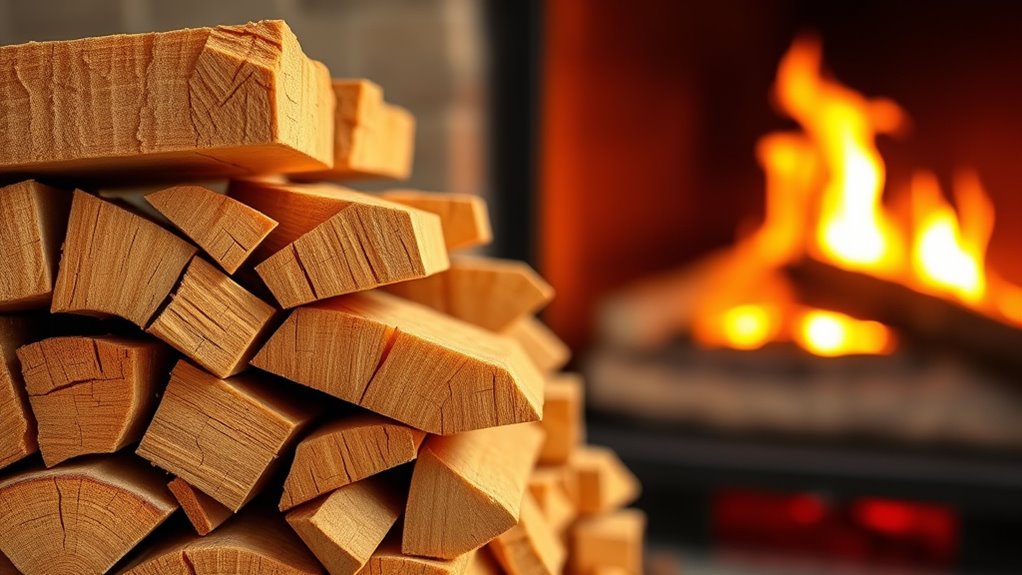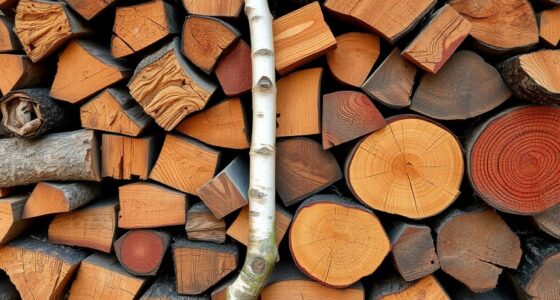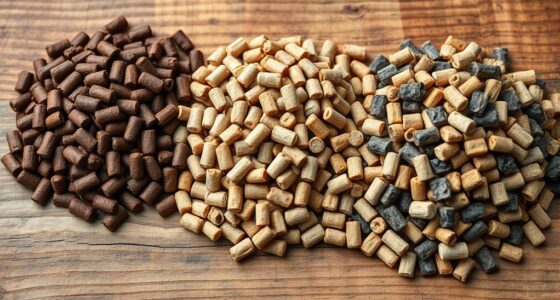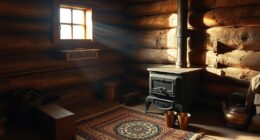Kiln-dried firewood burns more cleanly and efficiently, which means less smoke, soot, and creosote buildup in your chimney. With moisture levels below 20%, it ignites quickly and produces more heat from each log, saving you time and money. Plus, it’s better for the environment and healthier for your indoor air quality. Keep going to discover how kiln-dried logs can transform your fire experience and help you enjoy a safer, cleaner burn.
Key Takeaways
- Kiln-dried firewood has moisture content below 20%, resulting in cleaner and more complete combustion.
- Reduced water content minimizes smoke, soot, and creosote buildup, leading to cleaner emissions.
- Easier ignition and steady burns decrease smoke production and improve indoor air quality.
- Efficient combustion from kiln-dried logs lowers particulate emissions and environmental impact.
- Less creosote and soot reduce chimney maintenance, promoting safer and cleaner burns.
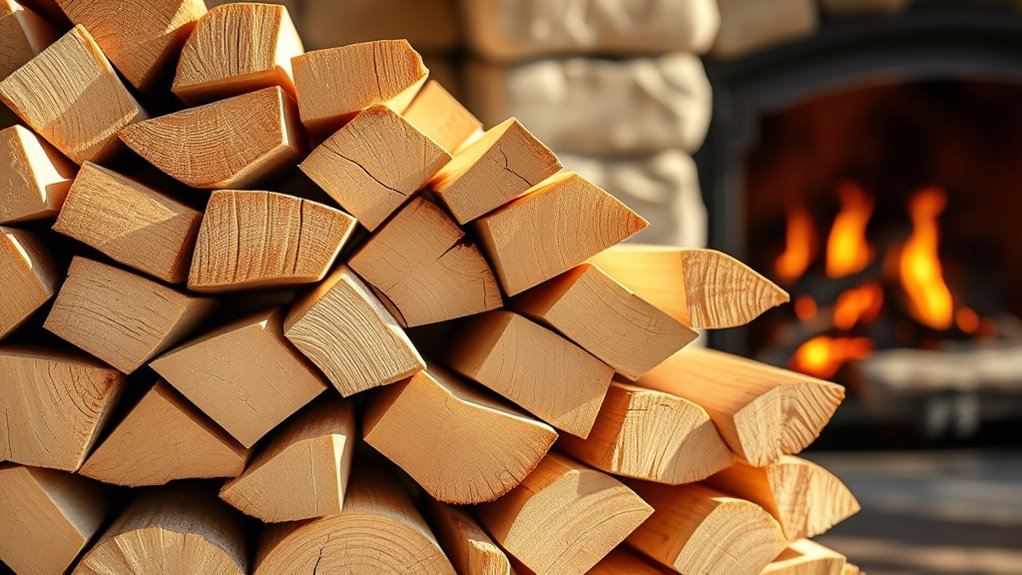
Using kiln-dried firewood can substantially improve your heating experience by providing cleaner, more efficient combustion. One of the key factors behind this improvement is the low moisture content of kiln-dried wood. Unlike seasoned or green wood, kiln-dried firewood typically has a moisture content below 20%, sometimes even as low as 15%. This reduced moisture level means you’re not just burning wood—you’re burning fuel optimized for maximum energy output. When moisture is high, a significant portion of the heat generated goes into evaporating the water, which leads to incomplete combustion and wasted energy. By reducing the moisture content, kiln-dried firewood allows your stove or fireplace to burn hotter and more completely, making every log count.
This increase in combustion efficiency isn’t just about better heat; it also means less creosote buildup in your chimney. When wood has high moisture, it produces more smoke, soot, and creosote, which can accumulate and pose fire hazards. Kiln-dried wood burns cleaner because it produces fewer particulates and less smoke. As a result, you’ll notice less soot on your glass and a cleaner chimney, reducing the frequency and cost of cleaning services. Additionally, cleaner burns mean fewer emissions released into the environment, making kiln-dried firewood a more eco-friendly choice. HEPA filters in air purifiers operate more effectively when indoor air quality is improved, further supporting a healthier environment.
You’ll also find that kiln-dried firewood ignites more easily and burns more steadily. Because the moisture content is low, you don’t need to spend extra time trying to dry out the wood before use. This consistency in ignition and burn rate ensures that your heating system operates smoothly, providing you with reliable warmth during cold months. The efficient combustion further maximizes the heat output, so you get more warmth from fewer logs. Over time, this can save you money, since you won’t need to purchase as much firewood to keep your home cozy.
Frequently Asked Questions
How Long Does Kiln-Dried Firewood Stay Dry?
Kiln-dried firewood stays dry for about 1 to 2 years if stored properly. You should keep it in a well-ventilated, dry location to maintain low moisture retention. Proper storage duration guarantees the wood remains easy to ignite and produces cleaner burns. Keep it off the ground and covered to prevent excess moisture from seeping in, ensuring your firewood stays dry and ready whenever you need it.
Is Kiln-Dried Firewood More Expensive Than Seasoned Wood?
Yes, kiln-dried firewood is generally more expensive than seasoned wood. The cost comparison reflects the additional processing and drying time involved in kiln drying, which can increase the price factors. You pay a premium for the convenience, cleaner burns, and higher energy efficiency. While it costs more upfront, many find the benefits worth the investment, especially for consistent, cleaner fires and less smoke.
Can Kiln-Dried Firewood Be Stored Outdoors Long-Term?
Yes, you can store kiln-dried firewood outdoors long-term, but you should take precautions. Its moisture resistance helps keep it dry, but proper outdoor storage is key. Use a covered shelter or stack it off the ground to prevent exposure to rain and snow. This way, the firewood stays dry and maintains its quality, ensuring cleaner burns and efficient heating whenever you need it.
Does Kiln Drying Remove All Pests and Mold?
You might think kiln drying removes all pests and mold, but it’s not foolproof. While it effectively kills most pests and prevents mold growth, some spores or eggs may survive if conditions are ideal. For pest eradication and mold prevention, kiln drying substantially reduces risks, but you should still inspect your firewood before use. Proper storage and handling remain essential to keep pests and mold at bay.
How Does Kiln-Dried Firewood Impact Indoor Air Quality?
Kiln-dried firewood considerably improves indoor air quality by reducing moisture and contaminants that can cause indoor pollution. When you burn kiln-dried wood, combustion efficiency increases, meaning less smoke and harmful emissions are released. This cleaner burn minimizes indoor air pollutants, making your home healthier. Plus, less creosote buildup decreases fire risks and indoor odors, ensuring a safer, cleaner environment for you and your family.
Conclusion
Switching to kiln-dried firewood transforms your fireplace experience into a blazing, cleaner-burning masterpiece. Say goodbye to smoke, creosote buildup, and endless ash mess — with kiln-dried wood, you’ll enjoy crackling flames that light up your home and warm your heart like never before. It’s so efficient, you’ll wonder how you ever managed without it! Embrace the power of kiln-dried firewood and watch your fires burn brighter, cleaner, and more effortlessly than you ever thought possible.

